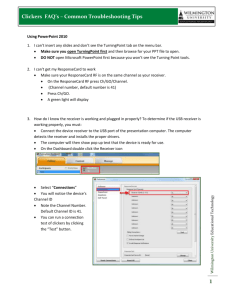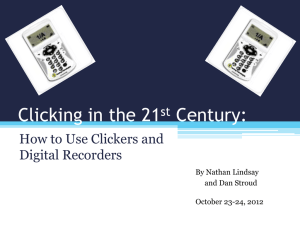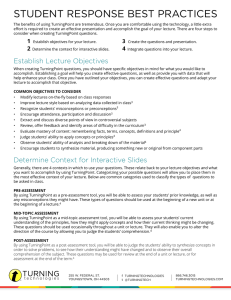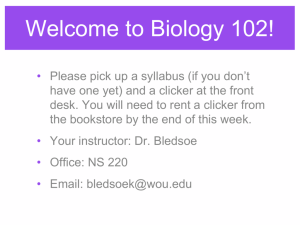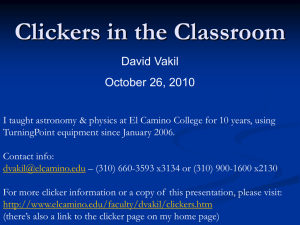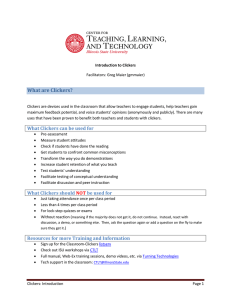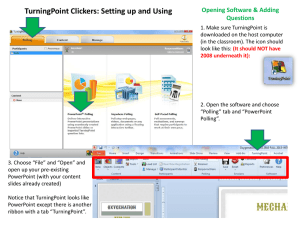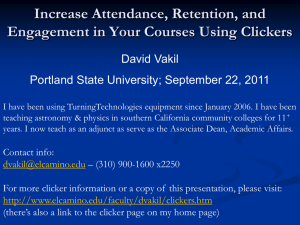855_0475Visconti_Colleen_F._056582_111406102303
advertisement
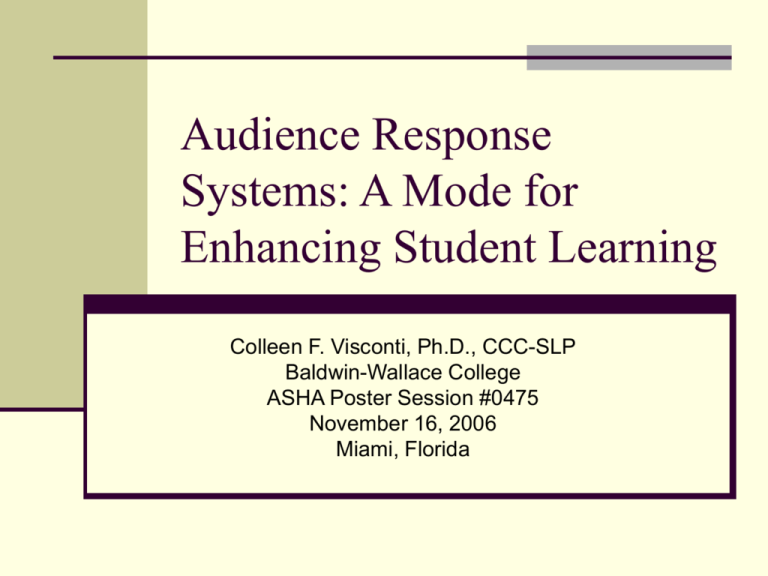
Audience Response Systems: A Mode for Enhancing Student Learning Colleen F. Visconti, Ph.D., CCC-SLP Baldwin-Wallace College ASHA Poster Session #0475 November 16, 2006 Miami, Florida Abstract The educational environment is forever changing and technology is a large part of the changes that have occurred. The Audience Response System is one of the new technologies available for enhancing student learning in the classroom. The purpose of this presentation is to discuss the TurningPoint Audience Response System, the various uses of this technology in the fields of communication sciences and disorders, and its benefits for both the students and the faculty in the classroom setting. System Requirements to Support TurningPoint Windows 98, 2000 or XP Microsoft Office 2000, XP or 2003, should include PowerPoint, Excel, Word and Outlook Pentium 3 Processor with 650MHz, 128 MB RAM 100 MB free disk space The “Clicker” Hardware Types of Interaction Reality Check Knowledge Check View Check Choice Check Fact Check Self Check Group Check Pulse Check Fun Check Reality Check Practical application – the intent is to move from ideas to action. What would you do if ? How would you treat X patient? How would you ? Knowledge Check Testing understanding – measure effectiveness What did you learn? Practice exam questions Quizzes Terminology understanding Causes for disorders Treatment options Assessment options View Check Opinion surveys – gather data from the audience Ethical issues Case management issues Environmental causes Caregiver roles Cultural issues Choice Check Spark controversy – think hard about an issue What would you choose? Theoretical controversies Opposing treatment philosophies Fact Check Share information – activates interest in a topic What do you know about X disorder? The preferred treatment approach for X disorder is . Which factors impact treatment goals? Statistics about various disorders. Self Check Self-assessment – audience self-analysis What do you think you know? Reviews before exams Introductions to a topic Application of concepts Group Check Audience Profiling – get audience demographics Who are you? Year in school Major Minor Courses completed Areas of interest Pulse Check Speedometer – Stay in touch with the audience How do you feel? How is this class going? Pacing of information Types of activities Fun Check Lightening up the pace – humorous interlude Can you smile? Are you awake? I want to go home. The Basics Create a PowerPoint presentation with TurningPoint Present presentation to class Students then respond to specific slides Data is automatically generated and projected after each slide Data can be saved for later Can check specific student performance, if student is assigned a specific “clicker” number Use at Baldwin-Wallace College 2005-2006 - faculty members began using Audience Response Systems Currently 18 faculty members are trained in its use 12 faculty members responded to a survey regarding use and the following data is based on those results. It is being used in at least 24 different courses, some with multiple sections Frequency of Use 4 3 2 1 0 Daily 1-2x per week Couple Times per month Once a month 1-2x per Semester Once a Semester Once a year Types of Interaction 9 8 7 6 5 4 3 2 1 0 Reality Check Knolwedge Check View Check Choice Check Fact Check Self Check Group Check Pulse Check Fun Faculty Benefits Greater participation & engagement Opens up class discussion Eliminates group induced bias Makes all students think about the question(s) Quick assessment of student understanding Identifies areas of confusion Anonymity Teaches students to read simple statistics Students own the data which leads to ownership of the class Less grading time of quizzes Student Benefits Keeps them engaged Confirms their understanding of the material compared to their peers Participation without speaking Immediacy of feedback Anonymity More interesting for the students Faculty limitations and downsides Preparation Time Preparing the PowerPoint Handing out remotes Doesn’t fit all courses Students don’t take notes when using it Passive tool for students – although it does generate discussion Technical glitches Student Response to the Clickers 90 80 70 60 50 40 30 20 10 0 Positive Response Students like it Neutral Response Students don't really care Negative Response Students don't like it Impact on Learning Currently, it is not clear how the use of clickers impacts learning. It is believed that since the students are more engaged in the course content, there should be an increase in the retention of the material. One faculty member, Dr. Margie Martyn, is currently investigating the impact of using clickers in the classroom on learning outcomes. Some Classroom Response Systems Response Card from TurningTechnologies, LLC (www.turningtechnologies.com) Classroom Performance Systems from eInstruction (www.einstruction.com) InterWrite Personal Response System from GTCO CalComp Corp. (www.gtcocalcomp.com) Classoom Reponsse System from HyperInteractive Teaching Technology (www.h-itt.com) Uses Outside of the Classroom Faculty training for grading reliability of common course papers Faculty meetings – vote on faculty governance issues Polling faculty on campus issues “Technology is not the lesson, but the mode of delivery for the lesson.” (Baker & Baker, 2004, p. 151) Suggested Readings Astleitner, H. & Leutner, D. (2000). Designing instructional technology from an emotional perspective. Journal of research on computing in education, 32(4), 497-510. Baker, P. & Baker, P. (2004). Teacher adjustment to technology: Overcoming cultural mindsets. Journal of Educational Technology Systems, 33(2), 147-156. Brewer, C.A. (2004). Near real-time assessment of student learning and understanding in Biology courses. BioScience, 54(11), 1034-1039. Draper, S. W., & Brown, M. I. (2004). Increasing interactivity in lectures using an electronic voting system. Journal of computer assisted learning, 20, 81-94. Fitch, J.L. (2004). Student feedback in the college classroom: A technology solution. Educational technology research & design, 52(1), 71-81. Hines, L. (2005). Interactive learning environment keeps Modesto students engaged. T H E Journal, 33(2), 40-41. Retrieved January 20, 2006, from Academic Search Premier. Zemsky, R. (2000). The mission and the medium. Policy Perspecitves, 9(3), 1-12. Special Thanks to John DiGennaro, Manager Educational Technology, Information Technology. Thank you for training me in the use of the Audience Response System and for answering all of my questions. Dr. Susan Oldrieve, Director of the Center for Transformational Learning. Thank you for all of your ideas, suggestions and support. Thanks also goes to the Scholarly Teaching Program for providing funding to attend and present at the ASHA convention. For a copy of the handout for this poster session, please visit the ASHA convention website or email me at cviscont@bw.edu

